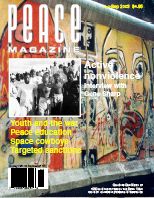
Peace Magazine Jul-Sep 2003, page 28. Some rights reserved.
Search for other articles by Rose Dyson here
Jonathan L. Freedman. University of Toronto Press, 2003
Jonathan Freedman is one of the last academics still holding out against the evidence that the media significantly influence levels of violence in society. In this book Freedman announces that his purpose is to provide a "comprehensive review" of the findings on media violence. The Motion Picture Association of America funded this review. Upon arriving at the University of Toronto, he began, with his students, an approach that did not include doing any research of his own, but rather criticizing what others had already done.
Almost all the studies he selected to review involve television violence -- some well known, others dated and obscure. Where evidence of harmful effects was found, Freedman criticizes both the quality of the methods and the findings. In cases where no harmful effects were found the methods often pass without comment.
According to Freedman, kids who get into trouble after watching a violent program may be excited or aroused, "but it is the arousal that affects them, not the content of the show itself."
Although his analysis of advertising techniques includes the acknowledgment that media can be "powerful," he excuses ads because they have "a clear, unmistakable message." Product placements in feature films and TV programs, advocacy advertising in public relations campaigns, spin doctoring in propaganda during elections, and blurring distinctions between news, entertainment, advertising and public relations have also escaped his observations as a psychologist.
Although he teaches in Toronto, he ignores major studies done in Canada, the most notable being the multidisciplinary Royal Commission on Violence in the Communications Industry appointed by the Ontario Government in 1975. Along with a review of the literature dating back over 50 years, an additional 28 studies were commissioned to fill in perceived gaps before the Report was released two years later with conclusions and recommendations pointing to the overwhelming weight of evidence in support of a link between media violence and real life violence. Nor did he examine the work done through the La Marsh Centre at York University, which carries on the work begun by the Commission.
Jacques Deguise and his colleagues at Laval University were also ignored, along with George Gerbner and his associates who have studied media violence for over 30 years. Educational theory and practice appear irrelevant to him.
Indeed, he goes so far as to assert that members of the American Psychological Association, the American Medical Association, the Canadian Paediatric Association and other counterpart organizations within the helping professions who sometimes testify in court cases against producers and distributors of media violence are running the risk of perjuring themselves.
Freedman sets himself up as the arbiter of findings and methods by other researchers while railing that the public has been "misled." His expressed biases include a preference for heavy metal music over string quartets, the latter described as "stodgy," and violent over nonviolent movies because they are always more "exciting." He explains that it is all "just entertainment."
Freedman does not acknowledge the socializing influences of television and other media that constitute a total cultural environment into which children are now born. He only considers such socializing influences as dysfunctional family life. He dismisses violence on television as too hypothetical to be considered a causal factor for real life violence or aggression. The possibility that these influences may be inter-related and fuel each other seems not to have occurred to him.
Trying to debunk links between media violence and desensitization, he misses the point. Steady, heavy diets of violent content can lead to what is known as "the mean world syndrome" -- a tendency to resort to tough law and order measures and an overestimation of the amount of violence in real life. Fear, anxiety, insecurity, and depression can interact with aggression, creating responses that Freedman does not consider.
The book has some marginal value as a review of the limitations of research methodology. But Freedman has hitched his star to a dated academic approach just while communications technologies are converging with economic forces, rendering meaningless any examination of one form of media in isolation from others.

Peace Magazine Jul-Sep 2003, page 28. Some rights reserved.
Search for other articles by Rose Dyson here